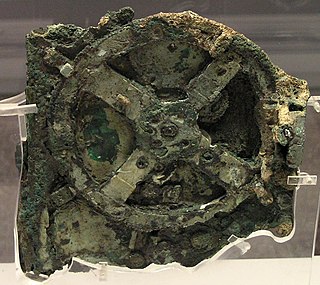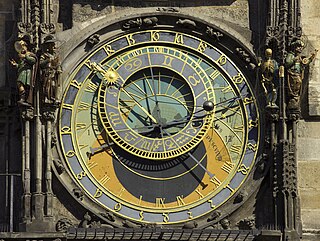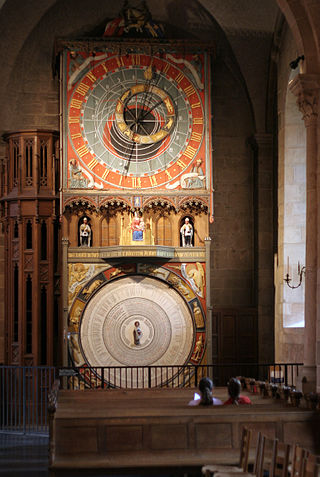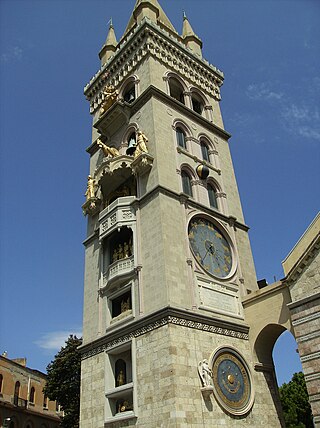
Wimborne Minster astronomical clock is a fourteenth-century astronomical clock in Wimborne Minster in Dorset, regarded as "one of the most ancient working clocks in Europe." [1]

Wimborne Minster astronomical clock is a fourteenth-century astronomical clock in Wimborne Minster in Dorset, regarded as "one of the most ancient working clocks in Europe." [1]

The clock dates back to the early fourteenth century, possibly around 1320. It is suggested that it was built by Peter Lightfoot, a Glastonbury monk. [2] The clock's case was built in the Elizabethan era, but the face and dial are of a much greater age; the first documents relating to the clock concern repairs carried out in 1409. [3] In early church records the clock is referred to as the "oryall". [4]
In 1593, the clock was removed from the central tower, and moved to its current location in the minster's west tower. [3] The clock's mechanism was replaced in 1695 and the present works were installed in 1792. [3] The gilded angels and cherubim which adorn the case were transplanted from the original organ case during church renovations undertaken in the Victorian era. [3] In 1979 restorations were carried out upon the clock which reproduced the simple designs discovered under the ancient layers of paint. [3]
The display on the clock is based upon the geocentric model, which was not superseded until the advent of heliocentrism in the late 16th century. The Earth is represented by a blue-green sphere positioned in the centre of the clock face. The Sun rotates in the outer blue ring and points to the hour of day. The gold/black orb in the inner starred ring represents the Moon, and shows the lunar phases. At full moon it is golden, and at new moon it is black. For intermediate phases it is partially black and gold in proportion to the phase.
The casing on the wall contains cogs which move the Sun and Moon models around the face of the clock. The movement is in the belfry. On the outside north wall of the minster is a full-size Grenadier, called the Quarterjack, which strikes the quarter hours. [5] The original figure of a monk was replaced during the Napoleonic Wars.

The Antikythera mechanism is an Ancient Greek hand-powered orrery, described as the oldest known example of an analogue computer used to predict astronomical positions and eclipses decades in advance. It could also be used to track the four-year cycle of athletic games similar to an Olympiad, the cycle of the ancient Olympic Games.

The Prague astronomical clock or Prague Orloj is a medieval astronomical clock attached to the Old Town Hall in Prague, the capital of the Czech Republic.

An astronomical clock, horologium, or orloj is a clock with special mechanisms and dials to display astronomical information, such as the relative positions of the Sun, Moon, zodiacal constellations, and sometimes major planets.

Yi Xing, born Zhang Sui, was a Chinese astronomer, Buddhist monk, inventor, mathematician, mechanical engineer, and philosopher during the Tang dynasty. His astronomical celestial globe featured a liquid-driven escapement, the first in a long tradition of Chinese astronomical clockworks.

The Zytglogge is a landmark medieval tower in Bern, Switzerland. Built in the early 13th century, it has served the city as a guard tower, prison, clock tower, centre of urban life and civic memorial.

Astronomy in China has a long history stretching from the Shang dynasty, being refined over a period of more than 3,000 years. The ancient Chinese people have identified stars from 1300 BCE, as Chinese star names later categorized in the twenty-eight mansions have been found on oracle bones unearthed at Anyang, dating back to the mid-Shang dynasty. The core of the "mansion" system also took shape around this period, by the time of King Wu Ding.

The Torrazzo is the bell tower of the Cathedral of Cremona, Lombardy, in northern Italy.

Wimborne Minster is the parish church of Wimborne, Dorset, England. The minster has existed for over 1300 years and is recognised for its unusual chained library. The minster is a former monastery and Benedictine nunnery, and King Æthelred of Wessex is buried there.

The Wells Cathedral clock is an astronomical clock in the north transept of Wells Cathedral, England. The clock is one of the group of famous 14th– to 16th–century astronomical clocks to be found in the West of England. The surviving mechanism, dated to between 1386 and 1392, was replaced in the 19th century, and was eventually moved to the Science Museum in London, where it continues to operate. The dial represents the geocentric view of the universe, with the Sun and Moon revolving round a central fixed Earth. It may be unique in showing a philosophical model of the pre-Copernican universe.

St Stephen's is the parish church of Pamphill in Dorset, England.

Egyptian astronomy began in prehistoric times, in the Predynastic Period. In the 5th millennium BCE, the stone circles at Nabta Playa may have made use of astronomical alignments. By the time the historical Dynastic Period began in the 3rd millennium BCE, the 365 day period of the Egyptian calendar was already in use, and the observation of stars was important in determining the annual flooding of the Nile.

A jacquemart is an automaton, an animated, mechanised figure of a person, usually made from wood or metal, which strikes the hours on a bell with a hammer. Jacquemarts are usually part of clocks or clocktowers, and are often near or at the top of the construction. The figurine is also known as Jack of the Clock or Jack o'Clock.

The Minster Church of All Saints or Rotherham Minster is the Anglican minster church of Rotherham, South Yorkshire, England. The Minster is a prominent example of Perpendicular Gothic architecture and various architectural historians have rated it highly. Nikolaus Pevsner describes it as "one of the largest and stateliest churches in Yorkshire", Simon Jenkins states it is "the best work in the county", and Alec Clifton-Taylor calls it the "glory of Rotherham". With its tall spire, it is Rotherham's most predominant landmark, and amongst the tallest churches in Yorkshire.

The Exeter Cathedral Astronomical Clock is a fifteenth-century astronomical clock in Exeter Cathedral, England. It displays the hour of the day, the day of the lunar month and the phase of the moon. The modern clock mechanism was installed in 1885 by Gillett & Bland of Croydon, and restored in 1910.

Lund astronomical clock, occasionally and at least since the 16th century referred to as Horologium mirabile Lundense, is a 15th-century astronomical clock in Lund Cathedral. Mentioned in written sources for the first time in 1442, it was probably made and installed sometime around 1423–1425, possibly by Nikolaus Lilienfeld. It is part of a group of related medieval astronomical clocks found in the area around the south Baltic Sea. In 1837 the clock was dismantled. Between 1909 and 1923, it was restored by the Danish clockmaker Julius Bertram-Larsen and the Swedish architect responsible for the upkeep of the cathedral, Theodor Wåhlin. From the old clock, the face of the clock as well as the mechanism, which was largely replaced during the 18th century, was salvaged and re-used. The casing, most parts of the calendar which occupies the lower part, and the middle section were made anew.

Ottery St Mary Astronomical Clock is a 14th-century astronomical clock in St Mary's Church, Ottery St Mary, in Devon in south-west England.

The Gros-Horloge is a 14th century astronomical clock in Rouen, Normandy.
The Lyon astronomical clock is a seventeenth-century astronomical clock in Lyon Cathedral.

The astronomical clock of Messina is an astronomical clock constructed by the Ungerer Company of Strasbourg in 1933. It is built into the campanile of Messina Cathedral.

The Torre dell'Orologio is a 15th-century renaissance tower on the Piazza delle Erbe in Mantua, Italy. It is attached to the Palazzo della Ragione, and next to the Rotonda di San Lorenzo. It houses an astronomical clock.
oryall.